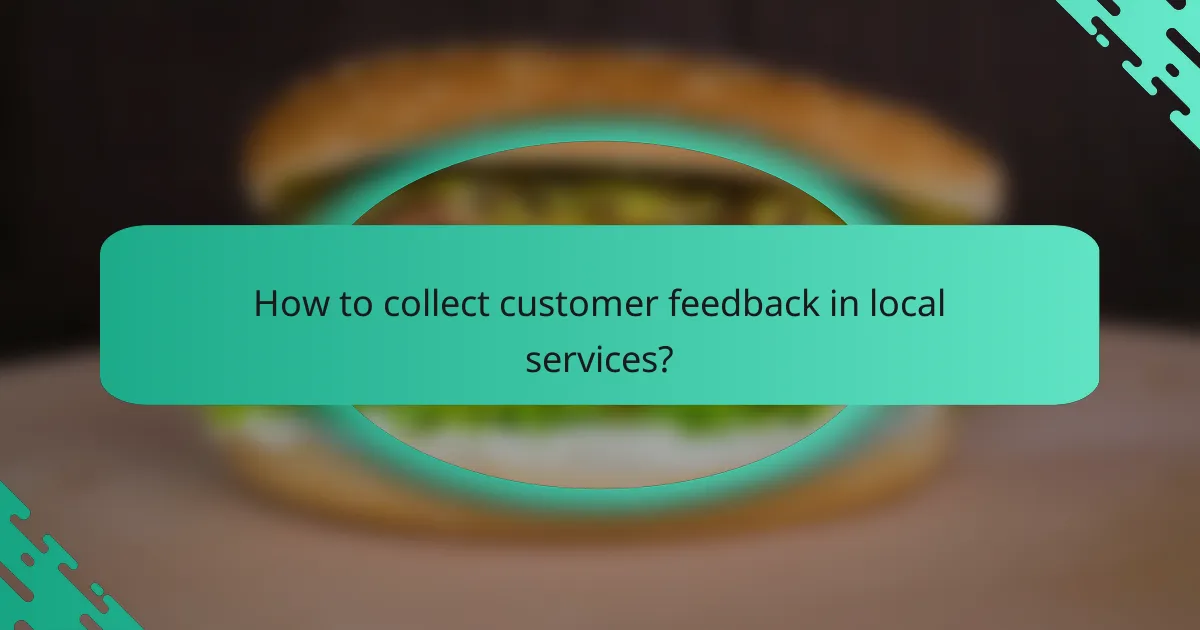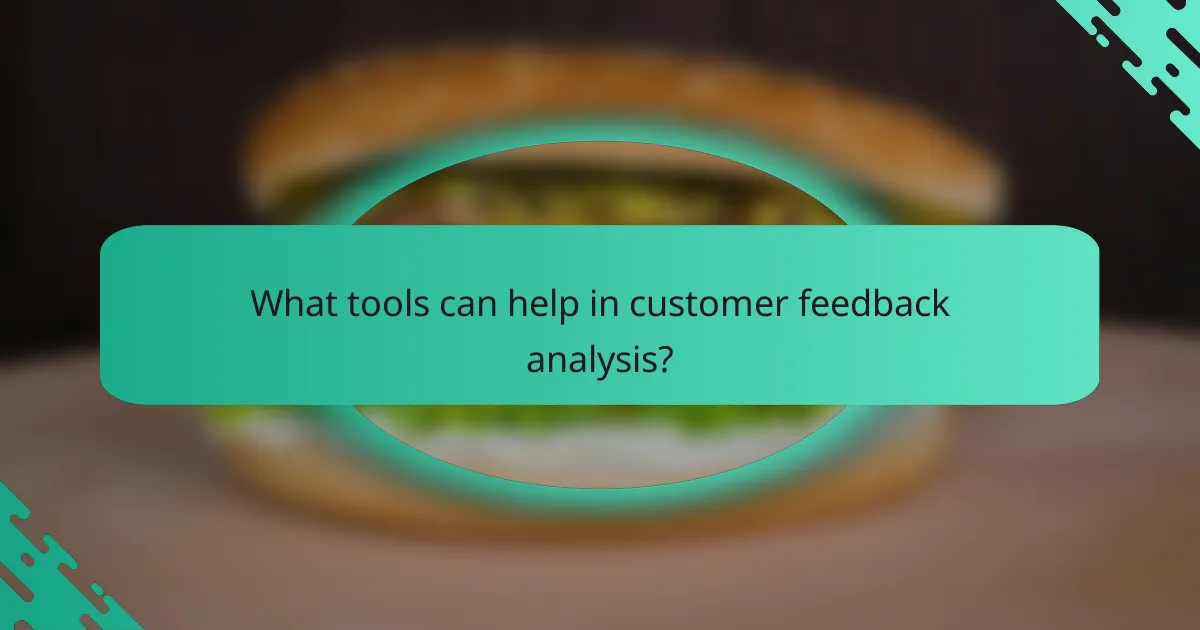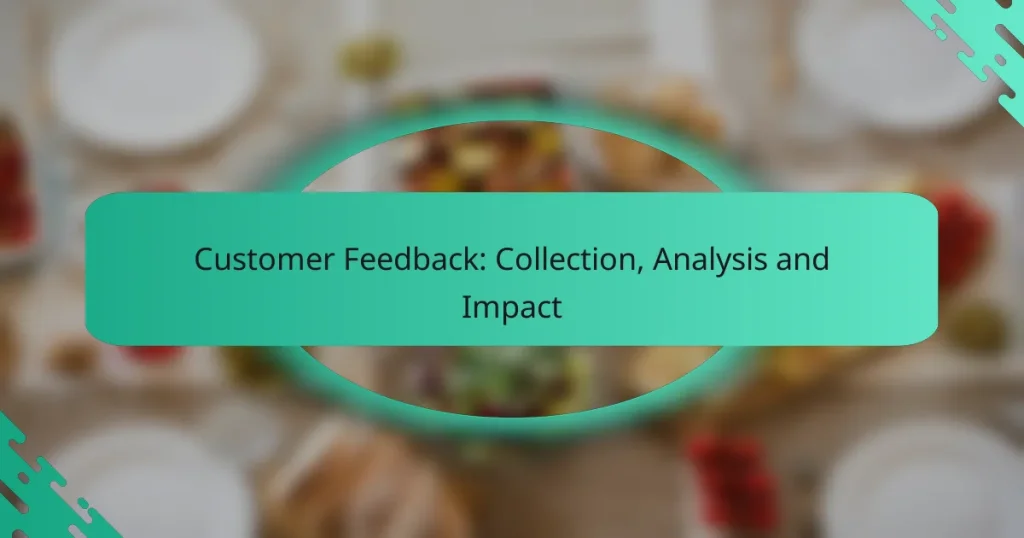Customer feedback is a vital component for local services, enabling businesses to gauge client satisfaction and identify areas for improvement. By employing effective collection and analysis methods, companies can enhance service quality, foster loyalty, and make informed decisions that positively impact customer experiences.

How to collect customer feedback in local services?
Collecting customer feedback in local services involves various methods that help businesses understand client satisfaction and areas for improvement. Effective feedback collection can enhance service quality and foster customer loyalty.
Online surveys
Online surveys are a popular method for gathering customer feedback due to their convenience and scalability. Tools like Google Forms or SurveyMonkey allow businesses to create customized questionnaires that can be distributed via email or social media.
To maximize response rates, keep surveys short, ideally under 10 questions, and consider offering incentives such as discounts or entries into a prize draw. Aim for a response rate of at least 20-30% for meaningful insights.
In-person interviews
In-person interviews provide an opportunity for deeper insights into customer experiences. Conducting these interviews in a comfortable setting allows for open dialogue and can reveal nuanced feedback that surveys might miss.
Prepare a set of open-ended questions to guide the conversation, and be flexible to explore topics that arise. Limit interviews to 30-60 minutes to respect customers’ time while gathering valuable information.
Feedback forms
Feedback forms can be placed at service locations or sent electronically after a service interaction. These forms should be straightforward, allowing customers to rate their experience and provide comments.
Consider using a mix of quantitative ratings (e.g., 1-5 stars) and qualitative fields for comments. Ensure forms are easy to fill out, and follow up with customers who provide detailed feedback to show appreciation and encourage future engagement.
Social media polls
Social media polls are an engaging way to collect quick feedback from customers. Platforms like Facebook and Instagram allow businesses to create simple polls that can gauge customer preferences or satisfaction levels.
Keep polls concise, with 2-4 options, and promote them to encourage participation. Analyze the results to identify trends and inform service improvements, while also engaging with customers who participate.
Customer service interactions
Customer service interactions are a valuable source of feedback, as they provide real-time insights into customer satisfaction. Train staff to ask for feedback during or after service interactions, either verbally or through follow-up emails.
Implement a system to track feedback from these interactions, categorizing comments to identify common issues or areas for improvement. Regularly review this data to enhance service quality and address customer concerns promptly.

What are the best practices for analyzing customer feedback?
To effectively analyze customer feedback, businesses should employ a combination of quantitative and qualitative methods that provide insights into customer sentiments and preferences. Best practices include using sentiment analysis tools, categorizing data, identifying trends, and benchmarking against competitors to enhance decision-making.
Sentiment analysis tools
Sentiment analysis tools help businesses gauge customer emotions expressed in feedback, reviews, and social media. These tools utilize natural language processing to classify sentiments as positive, negative, or neutral, allowing companies to quickly assess overall customer satisfaction.
Popular sentiment analysis tools include Google Cloud Natural Language, IBM Watson, and various social media monitoring platforms. When selecting a tool, consider factors such as ease of use, integration capabilities, and the ability to analyze multiple languages if operating in diverse markets.
Data categorization
Categorizing customer feedback is essential for identifying specific issues and areas for improvement. This process involves grouping feedback into themes or topics, such as product quality, customer service, or pricing, which can help pinpoint where changes are needed.
Utilizing tagging systems or predefined categories can streamline this process. Regularly review and update categories to reflect evolving customer concerns and ensure that the analysis remains relevant and actionable.
Trend identification
Identifying trends in customer feedback allows businesses to recognize patterns over time, such as recurring complaints or increasing satisfaction levels. This can be achieved through regular analysis of feedback data, looking for shifts in sentiment or frequency of specific issues.
Consider using visualization tools like charts or graphs to illustrate trends clearly. Regularly scheduled reviews, such as monthly or quarterly, can help maintain a pulse on customer sentiment and inform strategic decisions.
Benchmarking against competitors
Benchmarking against competitors involves comparing your customer feedback metrics with those of similar businesses. This practice provides context for your performance and highlights areas where you may be lagging or excelling.
To benchmark effectively, gather data on competitors’ customer satisfaction scores, feedback trends, and industry standards. Tools like Net Promoter Score (NPS) can be particularly useful for making these comparisons, helping you to set realistic goals and improve your offerings based on industry insights.

How does customer feedback impact local service businesses?
Customer feedback significantly influences local service businesses by shaping their operations and enhancing customer experiences. By actively collecting and analyzing feedback, these businesses can make informed decisions that lead to improved services and stronger customer relationships.
Improved customer satisfaction
Collecting customer feedback allows local service businesses to identify areas for improvement, directly enhancing customer satisfaction. For instance, if clients frequently mention long wait times, a business can adjust staffing or scheduling to address this issue.
Regularly engaging with customers through surveys or feedback forms can create a more responsive service environment. This proactive approach often leads to higher satisfaction ratings and positive word-of-mouth referrals.
Enhanced service offerings
Feedback provides valuable insights into customer preferences, enabling businesses to tailor their services accordingly. For example, a local café might discover that customers prefer organic ingredients, prompting a shift in their menu to include more health-conscious options.
By analyzing trends in customer feedback, businesses can innovate and expand their offerings, ensuring they meet evolving consumer demands. This adaptability can set a business apart from competitors in the local market.
Increased customer loyalty
When customers see their feedback being taken seriously, they are more likely to remain loyal to a business. Acknowledging and acting on feedback fosters a sense of community and trust, which is crucial for local service providers.
Implementing loyalty programs based on customer suggestions can further enhance this relationship. For instance, offering discounts or rewards for frequent customers can encourage repeat business and strengthen brand loyalty.
Revenue growth
Ultimately, the impact of customer feedback can lead to increased revenue for local service businesses. Satisfied customers are more likely to return and recommend the business to others, driving new customer acquisition.
By focusing on areas highlighted in feedback, businesses can optimize their operations and marketing strategies, resulting in higher sales. Investing in customer feedback mechanisms can yield significant returns, making it a crucial aspect of business strategy.

What tools can help in customer feedback analysis?
Several tools can effectively assist in customer feedback analysis, providing insights into customer sentiments and preferences. These tools range from survey platforms to data visualization software, each offering unique features suited for different analytical needs.
SurveyMonkey
SurveyMonkey is a popular online survey tool that allows businesses to create customized surveys to gather customer feedback. Its user-friendly interface enables quick setup and distribution, making it ideal for obtaining insights from a wide audience.
Key features include various question types, templates, and analytics tools that help interpret results. Businesses can easily share surveys via email or social media, and responses can be analyzed in real-time, providing immediate feedback on customer opinions.
Google Forms
Google Forms is a free tool that enables users to create surveys and questionnaires effortlessly. It integrates seamlessly with other Google services, allowing for easy data collection and storage in Google Sheets for further analysis.
While it may lack some advanced features of paid tools, its simplicity and accessibility make it a great choice for small businesses. Users can customize forms with different question types and themes, ensuring they capture relevant feedback effectively.
Qualtrics
Qualtrics is a comprehensive experience management platform that offers advanced survey capabilities and analytics. It is particularly beneficial for larger organizations looking to conduct in-depth customer research and track feedback over time.
With features like sentiment analysis and benchmarking, Qualtrics helps businesses understand customer experiences on a deeper level. It also supports various distribution methods, including mobile and email, making it versatile for different customer segments.
Tableau
Tableau is a powerful data visualization tool that can transform customer feedback data into interactive dashboards. It allows businesses to visualize trends and patterns in customer responses, making it easier to derive actionable insights.
While Tableau does not collect feedback directly, it excels in analyzing data from other sources, such as survey results. Users can create custom visualizations to highlight key metrics, helping teams make informed decisions based on customer feedback analysis.

What are the prerequisites for effective feedback collection?
Effective feedback collection requires a structured approach that includes clear objectives, appropriate tools, and a conducive environment for participants. Establishing these prerequisites ensures that the feedback gathered is relevant, actionable, and valuable for decision-making.
Clear objectives
Setting clear objectives is essential for effective feedback collection. Objectives define what you want to achieve, whether it’s improving a product, enhancing customer service, or gauging employee satisfaction. Without specific goals, the feedback may lack focus and relevance.
Consider using the SMART criteria—Specific, Measurable, Achievable, Relevant, and Time-bound—to formulate your objectives. For example, instead of aiming to “improve customer satisfaction,” a clearer objective would be “increase customer satisfaction scores by 15% within six months.” This specificity helps guide the feedback process.
Additionally, communicate these objectives to participants to ensure they understand the purpose of the feedback. This transparency can lead to more thoughtful and targeted responses, ultimately enhancing the quality of the insights gathered.


